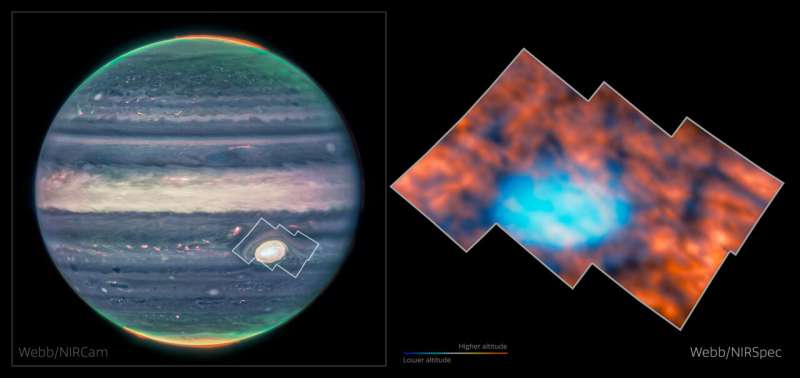phys.org | 2024 June 25
TY4YA JacNew observations of the Great Red Spot on Jupiter have revealed that the planet's atmosphere above and around the infamous storm is surprisingly interesting and active. This graphic shows the region observed by Webb—first its location on a NIRCam image of the whole planet (left), and the region itself (right), imaged by Webb's Near-InfraRed Spectrograph (NIRSpec). The NIRSpec image is stitched together from six NIRSpec Integral Field Unit images taken in July 2022, each around 300 square km, and shows infrared light emitted by hydrogen molecules in Jupiter's ionosphere. These molecules lie over 300 km above the clouds of the storm, where light from the sun ionises the hydrogen and stimulates this infrared emission. In this image, redder colours display the hydrogen emission from these high altitudes in the planet's ionosphere. Bluer colours show infrared light from lower altitudes, including cloud-tops in the atmosphere and the very prominent Great Red Spot. Jupiter is distant from the sun and therefore receives a uniform, low level of daylight, meaning that most of the planet's surface is relatively dim at these infrared wavelengths—especially compared to the emission from molecules near the poles, where Jupiter's magnetic field is especially strong. Contrary to the researchers' expectations that this area would therefore look homogeneous in nature, it hosts a variety of intricate structures, including dark arcs and bright spots, across the entire field of view.
[...]
"One way in which you can change this structure is by gravity waves—similar to waves crashing on a beach, creating ripples in the sand," explained Henrik. "These waves are generated deep in the turbulent lower atmosphere, all around the Great Red Spot, and they can travel up in altitude, changing the structure and emissions of the upper atmosphere."
[...]
more
